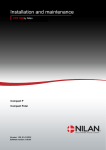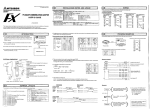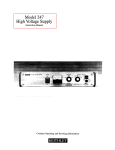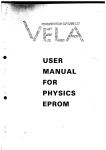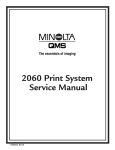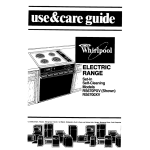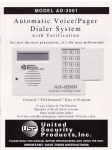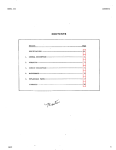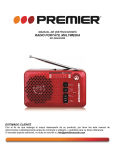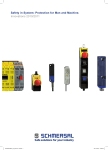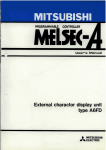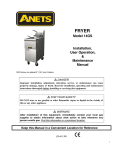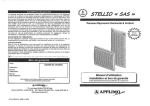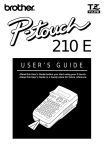Download Model 7158 Low Current Scanner Card Instruction Manual
Transcript
Model 7158 low Current Scanner Card Instruction Manual Contains Operating and Servicing Information Model Low Current Scanner Card Instruction Manual 7158 0 1987, Keithley Instruments, Test Instrumentation Inc. Group All rights reserved. Cleveland, June 1990, Document Ohio, U.S.A. Second Printing Number: 7158-901-01 Rev. B SAFETY PRECAUTIONS The following safety precautions should be observed before using this product and any associated instrumentation. Although 6ome instruments and accessories would normally be used with non-hazardous voltages, there are situations where hazardous conditions may be present. This product is intended for use by qualified personnel who recognize shock hazards and are familiar with the safety precautions required to avoid possible injury. Read the operating information carefully before using the product. Exercise extreme caution when a shock hazard is present. Lethal voltage may be present on cable connector jacks or test fixtures. The American National Standards Institute (ANSI) states that a shock hazard exists when voltage levels greater than 30V RMS, 42.4V peak, or 60VDC are present. A good safety practice is to expect that hazardous voltage is present in any unknown circuit before measuring. Before operating an instrument, make sure the line cord is connected to a properly grounded power receptacle. Inspect the connecting cables, test leads, and jumpers for possible wear, cracks, or breaks before each we. For maximum safety, do not touch the product, test cables, or any other instruments while power is applied to the circuit under test. ALWAYS remove power from the entire test system and discharge any capacitors before: connecting or disconnecting cables or jumpers, installing or removing switching cards, or making internal changes, such as installing or removing jumpers. Do not touch any object side of the circuit under measurements with dry capable of withstanding that could provide a current path to the common test or power line (earth) ground. Always make hands while standing on a dry, insulated surface the voltage being measured. Do not exceed the maximum signal levels of the instruments and awesseries, as defined in the specifications and operating information, and as shown on the instrument or test fixture rear panel, or switching card. Do not connect switching cards directly to unlimited power circuits. They are intended to be used with impedance limited sources. NEVER connect switching cards directly to AC main. When connecting sources to switching cards, install protective devices to limit fault current and voltage to the card. When fuses are used in a product, replace with same type and rating for continued protection against fire hazard. Chassis connections must only be used as shield connections ing circuits, NOT as safety earth ground connections. for measur- If you are using a test fixture, keep the lid closed while power is applied to the device under test. Safe operation requires the use of a lid interlock. If a @ screw is present on the test fixture, connect it to safety earth ground using #18 AWG or larger wire. The f symbol on an instrument or accessory indicates that 1OOOVor more may be present on the terminals. Refer to the product manual for detailed operating information. Instrumentation and accessories should not be connected to humans Maintenance should be performed by qualified service personnel. Before performing any maintenance, disconnect the line cord and all test cables. SPECIFICATIONS MODEL 7158 LOW CURRENT SCANNER CARD CHANNBLS PER CARD: 10 CONTACT CONFIGURATION: Single pole. When a channel is open, sign81 HI is connected to signal LO. Signal LO is common for ail 10 channels and aulput. CONNIXTOR TYPE; BNC RELAY DRIVE CURRENT: lOOmA per card typical. MAXIMUM SIGNAL 368 BANDWImHz LEVEL; lOOmA, 3OV, peak (resistive load) lM& typical. CONTACT LIFE: 10’ closures (cold switching); 10’ closures (at maximum signal level) CONTACT RESISTANCE: <Xl to rated life CONTACT POTBNTIALr <20,&V ACTUATION TIME: <Ims, exclusive of mainframe OPPSET CURReNT: COMMON MODR <10’“A (<3 x 10-laA typical) VOLTAGE: 3OV peak GENRRAL ENVIRONMENT, Operating: 8’ to 50°C, up to 35’C at 70% RH storage: -2.5” to 65°C DIMENSIONS, WEIGHI! 32mm high x 114mm wide x 272mm long (1%” x 4%” x 10%“). Net weight 0.5gkg (20.5 oz.) ACCBSSORY SUPPLIED; ACCBSSORY AVAILABLG; Model 4801 Low Noise Cable Model 4804 t&x female to BNC male adapter Specifications subject to change without notice. TABLE OF CONTENTS SECTION 1 - GENERAL 1.1 1.2 1.3 1.4 I.5 I.6 INFORMATION Introduction. ........................................ warrant\~ Information ................................ Manual.Addenda .................................... Safety Symbols and Terms ........................... Unpackmg and lnspectlon ............................ Specifications ........................................ 1 1 2 2 2 3 SECTION 2 - OPERATION 2.1 2.2 2.2.1 2.2.2 2.3 2.4 2.5 2.5.1 2.52 2.6 Introduction ......................................... Safety Precautions ................................... .................... High Impedance Considerations Static Precautions .................................. Connections and Cabling ............................. Installation and Removal ............................. Operation .......................................... Scanner Control of the Channels ................... Operation Notes .................................. Applications. ....................................... SECTION 3 - SERVICING 3. I 3.2 3.3 3.4 3.5 3.6 INFORMATION Introduction ........................................ Handling and Cleaning ............................. Relay Replacement .................................. Recommended Test Equipment ....................... Offset Current Test ................................. Contact Resistance Test .............................. SECTION 4 - REPLACEABLE 4.1 4.2 4.3 4.4 4.5 5 5 5 6 6 8 10 11 18 18 25 25 26 W W 29 PARTS introduction ........................................ Parts Lists ......................................... Ordering Information ............................... Factory Service ..................................... Component Layout and Schematic Diagram ........... 33 33 33 35 35 LIST OF TABLES SECTION 2 - OPERATION 2-l 2-2 2-3 2-4 2-5 2-6 2-7 Example Example Example Mode Scanner Scanner Scanner Scanner Channel Channel Channel Control Control Control Control Assignments Assignments Assignments of of of of Model Model Model Model SECTION 3 - SERVICING 3-l Recommended 4-Pole 2-Pole l-Pole Matrix Mode Mode Mode. (O-Pole) Mode. 12 13 14 15 15 16 17 INFORMATION Test Equipment, SECTION 4 - REPLACEABLE 4-l 4-2 7158 7l58 7l58 7158 in 2-P& Mode. in l-Pole Mode in Matrix (O-Pole) 27 PARTS Model 7l58 Electrical Parts. Model 7158 Mechanical Parts 34 35 iii/iv LIST OF ILLUSTRATIONS SECTION 2 - OPERATION 2-l 2-2 2-3 2-4 2-5 2-6 2-7 Multi-Card Connection. Installing Card in Model 705, Installing Card in Model 706.. Model 7l58 Simplified Schematic, Capacitor Leakage Schematic Capacitor Leakage Instrument Setu Measuring Leakages with One Car x ““” SECTION 3 - SERVICING 3-l 3-2 3-3 INFORMATION Offset Current Coax Pigtail Preparation. Contact Resistance SECTION 4 - REPLACEABLE 4-l 4-2 ., 7 9 10 11 20 21 23 28 30 31 PARTS Model 7l58 Component Layout Model 7l58 Schematic Diagram 36 37 v/vi SECTION 1 GENERAL INFORMATION 1.1 INTRODUCTION The Model single-pole will switch to any one 7l58 Low Current Scanner Card has ten channels of paired single-throw (SET), normally open (NO) relays. The card any one of ten signals to one output, or switch one signal of ten outputs. Signal HI is connected to signal LO (analog ground) when the scanner mainframe channel is open, and to output HI when the channel is closed. Signal LO is common to all ten channels and the output. An additional relay isolates all circuitry on the card from the output when no channel is closed. Features of the scanner card include: l l l l l Low offset current error (<IpA specified, <30fA typical) Switching of AC or DC signals up to lOOmA. BNC input and output connectors. Two outputs for daisy-chaining of Model 7158 cards. Configurable for low current or low voltage switching. The Model 7l58 is field-installable mainframes. 1.2 WARRANTY in the Models 705 and 706 scanner INFORMATION Warranty information is stated on the inside front cover of this manual. If there is a need for service, contact the Keithley representative or authorized repair facility in your area. Check the back cover for addresses. The service form supplied at the end of the manual should be used to provide the service facility with information concerning any difficulty. 1 1.3 MANUAL ADDENDA Product improvements or changes to this manual will be explained on an addendum included with the manual. It is recommended that this information be incorporated immediately into the appropriate ptaces in the manual. If an additional instruction manual is required, order the manual package (Keithley Part Number 7158-901-00). The manual package includes an instruction manual and all pertinent addenda. 1.4 SAFETY SYMBOLS AND TERMS The symbol A on the card denotes that the user should refer to the operating instructions. The WARNING used in this manual explains dangers that could result in personal injury or death. The CAUTION used in this manual explains hazards that could damage the card. 1.5 UNPACKING AND INSPECTION The Model 7158 was inspected both electrically and mechanically before shipment. Upon receiving the Model 7l58, unpack all items from the shippin carton and check for any obvious damage that may have occurred 6:urmg transit. Report any damage to the shipping agent. Retain and use the original packaging materials in case reshipment is necessary. The following items are shipped with every Model 7158: Model 7158 Low Current Scanner Card Model 7l58 Instruction Manual Model 4801 Low Noise Coax Cable (48 in., supplied 2 accessory) The following item is an optional accessory: Model 4804 Triax (F) to BNC (M) Adapter 1.6 SPECIFICATIONS Detailed specifications of this manual. of the Model 7158 precede the Table of Contents 314 SECTION 2 OPERATION 2.1 INTRODUCTION This section contains an operation overview, safety information, connections and cabling information, an installation procedure, operating instructions, and an application for the card. 2.2 SAFETY PRECAUTIONS WARNING Maintain inputs and outputs withln 30V peak of earth ground. lMn off all power and discharge stored energy in external cimultry before making or breaklng connections. 1. The maximum signal level is lOOmA peak (30V compliance). 2. Make sure the scanner mainframes are grounded through an earth grounded receptacle before operation. 3. Inspect all connections for wear and defects such as cracks and exposed wires. 2.2.1 High Impedance Considerations Because of the high impedance circuits on the card, be careful when handling it to avoid contamination from such foreign materials as body oils. Such contamination can substantially lower leakage resistance, degrading performance. Handle the card only by the edges. If you remove the relay covers, be careful not to touch board surfaces or exposed parts. To avoid dirt build-up over a period of time, operate the scanner and scanner card only in a clean environment. If contamination is suspected, the card should be carefully cleaned using the procedure given in paragraph 3.2. 2.2.2 Static Precautions The card’s IC chips are static-sensitive and can be damaged by static discharge, rendering the card partially or completely inoperative. For that reason, be careful not to touch exposed areas of the circuit board if static is thought to be a problem, CAUTION Static discharge to exposed circuits and might invalidate the warranty. 2.3 CONNECTIONS can damage the card AND CABLING Signal input and output connections are made with BNC connectors on the card. The locations for each channel input and the outputs are indicated on the relay covers. The two output connectors permit multiple Model 7158 cards to be connected together. For example, a 20.channel scanner system can be connected as shown in Figure 2-l. In addition to card-to-card connections, the Model 4801 low noise cable can be used for scanner-to-scanner connections when daisy-chaining up to five scanner mainframes. CAUTION Keithley’s Kelthley’s Model 7058 low current scanner card has trlax connectors, Be careful not to interchange trlax and BNC connectors to avold damaging them. Caps are provided for all connectors. Unused connectors should be capped to prevent contamination of the insulators, which could degrade performance. The supplied low noise coax cable has a conductive lubricant (graphite) to minimize the error current caused by friction between cable insulators and conductors. This becomes a consideration when measuring current levels in the picoamp range. Since cable flexing due to vibration and cable expansion and contraction due to temperature fluctuation cause friction, the signal cables should be fastened to a rigid surface and not subject to temperature changes. (The temperature changes normally experienced in laboratory environments are not a problem). Figure 2-1. Multi-Card Connection 2.4 INSTALLATION AND REMOVAL The procedures to install the Model 7l58 in the Model 705 or 706 Scanners are similar except for the card orientation. See Figure 2-2 for a Model 705 and Figure 2-3 for a Model 706. WARNING Turn off the scanner mainframe and disconnect the power cord before installing or removing scanner cards. CAUTION Leave the Model 7158 In Its anti-static bag until ready for cabling snd installing to avoid possible static damage. Once the card is cabled, insert it card edge first into the scanner mainframe by aligning it with the grooves in the appropriate slot. Make sure it is proper1 seated into the mainframe connector. Push the locking tabs forwar 1( to the center of the card to lock it in. To remove a card, first turn off the mainframe and all other equipment connected to the card. Unfasten the locking tabs on the card by pulling the tabs outward. Grasp the end of the card and carefully pull it out of the mainframe. J I Figure 2-2. Installing Card in Model 705 9 Figure 2-3. lnstalllng Card In Model 706 2.5 OPERATION As shown in Figure 24 for current switching, each channel on the Model 7158 has a pair of single-pole single-thmw (SKI), normally open (NO) relays. ‘Ihe relay pair switches signal HI between signal IQ (analog ground) and output HI. Signal LO (outside shell of the BNC) is common to all channels and outputs in the system. An additional relay isolates all circuitry on the card from the outputs when no channel is closed. That is, the isolation relay is open when all channels are open, and it is closed when any channel is closed, 10 The card is designed for scanning current sources: when a channel is not selected, a current path is maintained through its signal HI to LO relay. This protects sensitive devices under test from spikes when switching an ammeter in and out of each circuit. The Model 7158 can also be configured for voltage switching (schematic shown in Figure 2-48). This configuration is made possible by removing the socketed driver chips (Ul and U2) for the channel HI to LO relay coils. (These chips are static sensitive. See paragraph 3.2 for handling precautions) A. Current Swltchlng 6 8. Voltage Switching - - Flgure 2-4. Model 7166 Slmpllfled Schematic 11 2.5.1 Scanner Control of the Channels Since the Model 7158 is a lo-channel card, set the scanner to the 2-pole mode when using theMode 7158 by itself or when intermixing with other lo-channel cards (such as Models 7056,705& 7OC”,7066, and 7067). In the 2-pole mode, each scanner channel controls one channel on one lo-channel card. As an example, consider the combination of a Model 7158 and Model 7059. ‘table 2-l shows the scanner and card channel assignments for a master scanner. Table 2-l. Example Channel Assignments In 2.Pole Mode .~. Card 1 - Model 7158 10 channels Scanner Ch. No. 001 002 003 004 005 006 007 7158 Card 2 - Model 7059 10 channels Scanner 7059 Ch. No. Ch. No. Ch. No. 1 2 3 ii 011 012 073 014 015 016 017 018 019 020 1 2 3 4 5 ,6 7 8 6 7 008 8 009 010 9 10 lo” The Model 7l58 can be mtxed with cards other than lo-channel cards, but there are complications when changing the pole mode to support a mix of card types. When using a Model 7l58 in combination with a 20.channel card, such as the Model 7064, set the scanner to l-pole mode. In this mode, each scanner channel controls one channel on one 20-channel card. The effect on the Model 7l58 channel assignmen% is shown in Table 2-2. NOTE In the l-pole scanner mode, close one channel at a time when using the Model 7158. Otherwise, other channels are closed on the card and show up on the mainframe display. For example, close channels 2 and 5, channels 1 and 6 also close. Table 2-2. Example Channel Asslgnments In l-Pole Mode r Card 1 - Model 7158 10 ch; WlS Scanner 7158 Ch. No. Ch. No. 001 002 003 004 005 006 0”: 009 010 011 012 013 014 015 016 017 018 019 020 3 : 5 5 6 6 7 7 i ; 10 10 I Card 2 20 Scanner Ch. No. 021 022 023 024 025 026 027 028 029 030 031 032 033 034 035 036 037 038 039 040 de1 7064 lnels 7064 Ch. No. 1 2 3 4 : i 9 10 11 12 13 14 15 16 17 :i 20 Next, consider a mix of a lo-channel card Model 7l58), a 20-channel card (Model 7064), and a matrix card (Mode \ 7052) in a Model 706 scanner mainframe. Since a matrix card is present, the scanner is set to matrix (O-pole) mode. The scanner crosspoints and card channel assignments for a master scanner are shown in Table 2-3. Table 2-3. Example Channel Assignments in Matrix (O-Pole Mode) lard 1 - Model ‘7l.V Card 2 - Model 7064 20 chal R”lels 10 cha l”“l els 706 :rosspoi”l 001,l 002,l 003,l 004,l 005,l 001,2 002.2 003,2 004,2 005.2 7158 t c :h. 7064 706 No. Crosspoints i ( :h. No. : 3 4 5 ; 8 9 10 006.1 006.1 007,l 007,l 008.1 008,l 009,l 009,l 010.1 010.1 006.2 006,2 007,2 00x2 008,2 008,2 009,2 009,2 010,2 010.2 007.3 006,3 0073 006,3 ow,3 0063 007,3 006,3 007,3 006,3 007,3 006,3 007,3 006,3 0073 006,3 007.3 006,3 007,3 006,3 : 3 t 6 7 8 9 10 11 12 13 14 15 16 17 18 19 20 kd 3 - h Colum”! 706 Zrosspoinl 011.1 011,2 011,3 011,4 012,l 012,2 ol2,3 ol2,4 013.1 ol3.2 013.3 013.4 014,l 014.2 014,3 014,4 015.1 015,2 015,3 015,4 Id 7052 ,___~ 4 rows 7052 :ohmn, Row __~ ;*; 113 1.4 2,1 E 214 3.1 3.2 3.3 3.4 4.1 4.2 4,3 4,4 When using 20.channel cards in matrix mode, two crosspoints be closed for each of the card channels. in general, the rules for choosing different t: ;,3 5,4 must scanner pole modes are: matrix (O-pole) - If a matrix card is present. l-pole - If a 20-channel card is present, but no matrix card. 2-p& - If a lo-channel card is present, but no 20-channel or matrix cards. 14 4.pole - If 4-pole switching is desired with two 2-pole, IO-channel cards. Tables 2-4 through 2-7 list the scanner channels that conhol Model 7158 channels for all scanner pole configurations. Table 2-4. Scanner Control of Model 7158 cl-Pole Mode Card No. 1 s 4 2 i 9 10 Scanner Channel No. 01-10 01-10 11-20 11-20 21-30 21-30 31-40 31-40 41-50 41-50 7158 Channel No. I l-10 l-10 l-10 l-10 l-10 l-10 l-10 l-10 l-10 l-10 Scanner 705, 706 705, 706 706 706 706 706 706 706 706 706 Table 2-5. Scanner Control of Model 7158 2-Pole Mode Card No. 1 : 4 5 6 7 8 lo” Scanner Channel No. 7158 Channel No. Scanner 01-10 11-20 21-30 31-40 41-50 51-60 61-70 71-80 81.90 91.100 l-10 l-10 l-10 l-10 l-10 l-10 l-10 l-10 l-10 l-10 705, 706 705, 706 706 706 706 706 706 706 706 706 15 Table 2-6. Scanner Control of Model 7158 l-Pole Mode __- Card 1 Scanner Ch. No. Card 2 Scanner Ch. No. Card 3 Scanner Ch. No. Card 4 Scanner Ch. No. Card 5 Scanner Ch. No. ii32 15: 16 17, 18 19, 20 705, 706 21, 22 23, 24 25, 26 27, 28 29, 30 31, 32 33, 34 35, 36 37, 38 39, 40 705, 706 41, 42 43, 44 45, 46 47, 48 49, 50 51, 52 53, 54 55, 56 57, 58 59, 60 706 61, 62 63, 64 65, 66 6% 68 69, 70 71, 72 73, 74 75, 76 77, 78 79, 80 706 81, 82 83, 84 85, 86 87, 88 89, 90 91, 92 93, 94 95, 96 97, 98 99, 100 706 Card 6 Scanner Ch. No. Card 7 Scanner Ch. No. Card 8 Scanner Ch. No. Card 9 Ch. No. Card 10 Scanner Ch. No. 101, 102 103, 104 105, 106 107. 108 109, 110 111, 1x2 113, 114 115, 116 117, 118 119, 120 121, 122 123, 124 125, 126 127, 128 129,130 131, 132 133,134 135,136 137’ 138 139, 140 141, 142 143, 144 145, 146 147. 148 149, 150 151, 152 153, 154 155, 156 157, 158 159, 160 161, 162 163, 164 165, 166 167, 168 169, 170 171, 172 173, 174 175, 176 177, 178 179, 180 181, 182 183, 184 185, 186 187, 188 189, 190 191, 192 193, 194 195, 196 197, 198 199, 200 706 706 706 706 706 01, 03, 05, 07, 09, 02 04 06 08 10 7258 Ch. No. 1 3’ 4 5 6 8’ 9 10 Chmio -L: 3 4 5 ; 8 9 10 Table 2-7. Scanner Control of Model 7158 Matrlx (O-Pole)Mode 1 Card 1 7158 Ch. No. 06, 07. 08, 09, 10, 06, 07, 08, Card 6 icanner :h. 26, 1 27, 1 28, 1 29, 1 30, 1 26, 2 27, 2 28, 2 29, 2 3a 706 1 1 1 1 1 2 2 2 Card 7 Scanner Ch. No. 31, 32, 33, 34, 35, 31, 32, 33, 34, 35, ‘1 1 1 1 1 2 2 2 2 2 706 11, 12. 13, 14, 15, 11, 12, 13, 1 1 1 1 1 2 2 2 : 3 4 5 r+ 8 9 10 Card 8 kanner Ch. No. Card 9 Scanner Ch. No. 36, 1 37’ 1 38, 1 39, 1 40, 1 36, 2 37, 2 38, 2 39, 2 40, 706 41, 1 42, 1 43, 1 44 1 45, 1 41, 2 42, 2 43, 2 44 2 45, 2 706 Card 10 Scanner Ch. No. I 46, 1 47. 1 4% 1 49, 1 50, 1 46, 2 47, 2 ‘Ia 2 49, 2 50, 2 706 n.58 :h. No. 1 2 3 4 5 6 7 8 9 10 17 2.5.2 Operation Notes 1. Extreme environmental conditions can cause the offset current to exceed the 1pA specification. If the card has been exposed to high humidity and/or temperahue (for example during shipping), stabilize the board within the specified environmental limits for 24 hours. 2. When a channel is opened or closed, there is a charge transfer in the picocoulomb range. This is because of the mechanical release or closure of the contacts, the contact to coil capacitance, and the stray capacitance between signal and relay drive lines. The charge transfer causes a current pulse. The effect on the signal depends on the magnitude of the source being measured. 3. Each relay on the Model 7158 draws lOmA. For current switching, there are either ten or eleven relays energized with any combination of open and closed channels. The maximum current draw of one card from the mainframe power supply is 1lOmA. (For voltage switching, there are between zero and eleven relays energized for any open/closed channel combination.) There are no restrictions on the maximum number of simultaneous channel closures unless relays from other card types are energized at the same time. 4. System response is affected by cable capacitance. This should be considered when the sources are connected to the scanner. Use of a feedback ammeter (or an electrometer in the FAST mode) for currents below 10~‘A is recommended to increase measurement speed and decrease the effects of cable capacitance. 5. Power Limits - To prevent overheating or damage to the relay contacts, never exceed the signal level specifications of the card. Maximum switched and carry current and voltage levels are lOOmA, 30V. The card can switch low power AC (typical bandwidth up to lMHz). Maximum switched and carry current and voltage levels are lOOmA, 3OV, peak (resistive loads). 6. Switching Speed -Relay actuation time is lmsec maximum plus the mainframe programming time. Maximum relay switching rate is 100 cycles per second (10msec). This is the maximum rate of the scanner mainframe. For extended relay life, use low power or cold switching (turn on sources after the channel is closed). 2.6 APPLICATIONS The Model 7158 can be used in a variety of applications 18 to switch low current levels. Typical appltcations include those where sourcing voltage and measuring current are required, such as: l l l l Leakage currents (e.g. capacitor, FET gate) PCB test coupons Materials research and characterization Semiconductor sub-threshold current Voltage applications include those where the Model 7158 can be used to switch a single-pole of low voltage sources. (Refer to the application example that follows.) When measuring low currents, should be considered: l l l the following sources of noise current Triboelectric currents are caused by friction behveen a conductor and insulator when a coax cable flexes due to vibration or temperature fluctuation. To minimize, use low noise cables and tie down to a rigid surface. Piezoelechic currents are caused by mechanical stress to the insulating materials of connectors. Remove the stress from the insulators and use material with low piezoelectric effects to minimize. Electrochemical effects generate current between PCB conductors due to contamination of the card surface. To minimize, handle the card by the edges only and follow the cleaning instructions in paragraph 3.2. For a specific application, consider measuring capacitor leakage current to calculate insulation resistance. The amount of leakage current depends on the capacitor dielectric material as well as the applied voltage. The schematic of Figure 2-5 shows a Model 705517056 card on the source side, but a Model 7158 could be used in its voltage configmation when the test voltage does not exceed 3OV. The configuration shown is the direct method of measuring leakage currents: a feedback type picoammeter in series with the capacitor under test. This test is fully explained (including controlling software 19 and test fixture construction) Leakage Measurements”, in Application Note #l20, “Capacitor NOTE The indirect method, with a voltmeter reading the voltage drop across a resistor in series with the capacitor, is recommended for capacitor values above l@ to maintain stability and noise performance. The instrument setup is shown in Figure 2-6. For clarity, only four channels are shown. Obviously, all ten channels are available for testing purposes. r---- --7-----1 Figure 2-5. Capacitor Leakage Schematic 20 Figure 2-6. Capacitor Leakage Instrument Setup The internal voltage source of a Model 617 electrometer stagger charges the capacitors when the corresponding channels are closed on a Model 7056 general purpose card. (At this time, the signal HI to Lo relay on 21 the Model 7158 is closed, completing the circuit.) Resistor Rl is needed to limit current in case the capacitor is shorted and it also helps reduce noise. After each capacitor is fully charged (usually 10 times RlC), the Model 7I58 channel is programmed to close. This switches in the Model 617 for reading current or resistance (V/I mode). Once the Model 617 has settled and the measurement is taken, the Model 7l58 channel is opened and the signal HI to LO relay closes to shunt the current to ground. Then the Model 7056 channel is opened to avoid a current surge through the electrometer and resistors Rl and R2 bleed off the capacitor charge. With this two-card configuration, the capacitors have equal soak times. This is important when comparing low leakage levels (picoamps). Having equivalent soak times is not as critical at higher leakage levels (e.g. the nanoamp range of tantalum capacitors). In this case, the onecard configuration shown in Figure 2-7 is sufficient. Since the settling time of the Model 617 is less when measuring higher currents, the channels can be switched faster. 22 -------SHlELDED TEST FIXTURE Figure 2-7. Maasurlng Leakages wlth One Card 23/24 SECTION 3 SERVICING INFORMATION 3.1 INTRODUCTION ‘This section describes tests for verifying the performance of the Model 7158. Perform these tests in an environment of 18’C to 28’C up to 70% RH. Because of the low signal levels measured in these tests, the test cables should be kept as still as possible to help minimize noise. Recommended maintenance includes inspection of the card and the card edge connector to ensure good electrical contact. 3.2 HANDLING AND CLEANING Because of the high impedance of the board, take special care when handling and using to prevent degradation of performance. Handle the board by the edges to avoid contaminating it with dirt, body oil, etc. CMOS and other high-impedance devices are subject to possible static discharge damage because of the high impedance levels involved. When handling such devices (indicated by * in the parts list), use the following precautions: 1. Such devices should be transported and handled onl in containers specially designed to prevent or dissipate static bull,J -up. Typically, these devices will be received in anti-static containers of plastic or foam. Keep these parts in their original containers until ready for installation. 2. Remove the devices from their protective containers only at a roperly grounded work station. Also, ground yourself with a suita ITle wrwt strap. 25 3. Handle the devices only by the body; do not touch the pins. 4. Any printed circuit board into which the device is to be inserted must also be grounded to the bench or table. 5. Use only anti-static de-soldering tools and grounded-tip soldering irons. Before cleaning the board, remove the front and rear relay covers. Clean the board with cotton swabs or a soft brush saturated with an uncontaminated solvent, .such as Freon@ TMS or TE. After the solvent has been applied and is still liquid, blow-dry the board with dry-pumped nitrogen gas. 3.3 RELAY REPLACEMENT If you have determined cedure to replace it: that a relay is defective, use the following pro- 1. Remove the screws that secure the appropriate relay cover and remove the cover. 2. Unsolder the defective relay and clean the card holes with a desoldering tool or wick. Solder in a replacement relay. 3. Clean the card according to the method given in paragraph 3.2 using localized cleaning only, then reinstall relay covers. 26 3.4 RECOMMENDED TEST EQUIPMENT Table 3-1 lists recommended test equipment for performance verifici tion. Other test equipment may be substituted if specifications equa or exceed those stated. Table 3-l. Recommended Test Equipment Description -Scanner ~___ Mainframe Extender Card Low Noise Coax Cable Electrometer ‘l’riax to BNC Adapter Ohmmeter-DMM Kelvin Test Leads Specification 4 feet long 10.“A sensitivity <la sensitivity - KeithleG Keithley 196 5806 3.5 OFFSET CURRENT TEST This test verifies that the offset current specification. for each channel is within 27 1. Set up the equipment as shown in Figure 3-l with caps on all inputs and the unused output. 2. Insert the card,into the mainframe. 3. Set the electrometer to the 2pA range and zero check. 4. Turn on the mainframe and close channel 1. 5. Zero correct the Model 677 and release its zero check. Note the offset current long enough to allow the switching transients to decay and the current to stabdize. The current indicated by the electrometer should be less than lpA, exclusive of noise. Open the channel after taking the reading. 6. Close the remaining channels one at a time and repeat step 5. Figure 3-1. Offset Current 28 3.6 CONTACT RESISTANCE TEST This test verifies that the contact resistance of the relays does not exceed the specification. The procedure is in three parts: l l l Setting up equipment. Checking contacts of signal HI to LO relays (when channel is open). Checking contacts of signal HI to output HI relays in combination with the isolation relay (when channel is closed). Setting Up Equipment 1. Turn on the Model 196 DMM and let it warm up (two hours if from cold-start). 2. Using the following procedure, repare two BNC male connectors with coax pigtails as shown in k Igore 3-2. Use an X-acto” knife to cut and strip 1% inches of outer insulation without cutting the shield. l With the knife point, unravel the braided shield and twist it off to the side. l Strip one inch of insulation off the center conductor. 3. Connect the Model 7158 to the scanner through the Model 7061 Universal Adapter Card, which is used as an extender to allow access to all connectors. 4. Select the 3OOa range on the Model 196. Temporarily short the test leads and zero the instrument. Leave zero enabled for the duration of the test. l Checking Signal HI to LO Relays 5. Connect one of the BNC plugs to an input connector on the card. Connect the Kelvin leads to the coax pigtail as shown in Figure 3-3A. 6. $th all channels open, verify that the contact resistance is less than 7. Verify the resistance of the remaining signal HI to LO relays by just moving the BNC plug and Kelvin leads to the remaining input connectors and taking readings. 29 Flgure 3-2. Coax Plgtalt Preparatlon Checking Signal HI to Output HI Relays and Isolation Relay 8. Connect one of the BNC plugs to an input connector and the other BNC plug to an output connector. Connect the Kelvin leads to the coax pigtails as shown in Figure 3-38. 9. Program the scanner to close the channel being tested. This closes both the signal HI to output HI relay and the isolation relay for measuring. IO. Verify that the contact resistance of the relay combination (signal HI to LO relay and isolation relay) is less than 1% Open the channel after taking the reading. 30 11. Continue with the remaining channels by leaving one BNC plug on the output connector and moving the other BNC plug and Kelvin leads to the remaining input connectors. Take readings with the appropriate channel closed. Flgure 3-3A. Contact Resistance (Slgnal HI to LO Relays) 31 Figure 3-38. Contact Resistance (Signal HI to Output HI Relays) 32 SECTION 4 REPLACEABLE PARTS 4.1 INTRODUCTION This section contains replacement parts information, layout, and a schematic diagram for the Model ?l5g. a component 4.2 PARTS LISTS Electrical parts are listed in order of circuit designation in Table 4-l. Table 4-2 summarizes mechanical parts. 4.3 ORDERING INFORMATION To place a parts order or to obtain information about replacement parts, contact your Keithley representative or the factory. See the back cover for addresses. When ordering parts, be sure to include the following information: l l l l l Scanner card model number (7158) Card serial number Part description Circuit description (if applicable) Keithley part number 33 Table 4-1. Model 7158 Electrlcal Parts Circuit Desig. Cl Sch Description -LOC Keithley Part No. Al c-314-10 C2-C5 Capacitor, IOpF, 25V, Aluminum Electrolytic Capacitor, 0.M 5OV, Ceramic Film SW C-237-.1 11-112 Connector, sev CS-249 Kl-K21 Relay, SI’ST RI-RIO Resistor, 330kQ, 5%, NW, Carbon Composition Not used Resistor, 10kfI. 5%. ‘hW, Carbon Composition Resistor Network, lOkB, 2%, 1.5W, Thick Film se” R-76.330k 82 R-76.1Ok TE3, TE4, TE6, TE7, TEll, TEl Terminal, Teflon@ sev TE-105-1 Ul, u2* IC, Buffer/Line Driver and Receiver, 74HC241 IC, Hex Inverter, 74HC04 IC, Mnput NAND Gate, 74HCl33 sev IC-520 sev Bl IC-354 IC-547 Cable Assembly Sockets (2) 1 #18 AWG Bare Buss Wire X22 AWG Bare Buss Wire #22 AWG Natural Thinwall Teflon@ Tubing c4 n5a-wo 50-84-20 Rll R12, Rl.3 R14 u3, u4* u5* Wl Coaxial Female *These parts are static sensitive. precautions. 34 RL70 See paragraph TF-39 3.2 for handling Table 4-2. Model 7155 Mechanlcal Parts .!2!F 1 1 1 1 12 5 6 Keithley Part No. Description Bracket, Front Connector Mounting (CHS-CHlO) Bracket, Rear Connector Mounting (CHl-CH4, OUTPUT) Cable Clamp Cover, Front Relay (CHS-CHlO) Cover, Rear Relay (CHl-CH4, OUTPUT) Protective Cap (for BNC jacks) #4-40 x 3116 Phillips pan head sems screw (for bracket mounting) #6-32 x l/4 Phillips pan head sems screw (for cover mounting) 7158-303 7158-302 cc-38-4 7158-307 7158-304 CAP-18 4.4 FACTORY SERVICE If the scanner card is to be returned to Keithley Instruments perform the following: for repair, 1. Photocopy and complete the service form at the back of this manual and include it with the card. 2. Carefully pack the card in the original packing carton. 3. Write ATTENTION REPAIR DEPARTMENT on the shipping label. Note that it is not necessary to return the scanner mainframe with the card. 4.5 COMPONENT LAYOUT and SCHEMATIC DIAGRAM Figure 4-l shows a component layout of the Model 7I58. Figure 4-2 shows a schematic diagram of the Model 7l58. 35 Service Form Keithley Instruments, Inc. Test Instrumentation Group 28775 Aurora Road Cleveland, Ohio 44139 Printed in the U.S.A.














































